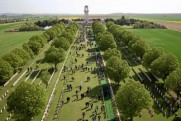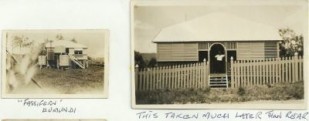WELLS Wilfred George
-
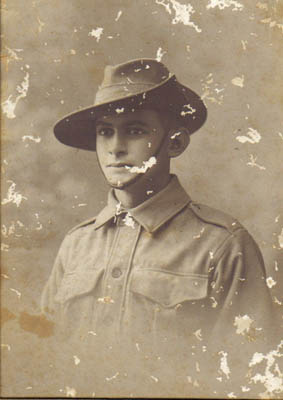
- 4784
- Private
- 25 Battalion
- 12th Reinforcements
- Verrierdale, Eumundi
- Yes
- 19 November 1897
- Berry, New South Wales
- 29 November 1915
- Mooltan
- 12 April 1916
- Sydney
-
A large tree in Memorial Drive, Eumundi honours the life of Wilfred George Wells, known to his family as Wilf. In all probability Wilf came to Eumundi on his pre-embarkation leave to visit his parents George Brooker Wells and Emma Victoria Wells (nee Cook). The town adopted him as one of its own. Wilf was born in Berry on 19 November, 1897 with an older brother Frederick (1895), and sister Anne(1893) and two younger siblings, Raymond (1907) and Winifred (1916). Family history records that when Wilf was leaving Eumundi he said goodbye to his three month old sister telling her not to grow up too much when we was away. He had been living independently of his parents in Bangalow, New South Wales for three years, apprenticed as a saddler and harness maker to Alfred Wilson. He enlisted in the A.I.F.in the 12th reinforcements, 25th battalion, at Lismore on 29 November, 1915 aged 18.
The Cook family arrived in Australia in 1859 and selected land at Brogers Creek, north of Berry, New South Wales . In those early days, dairying and timber cutting were the main industries of the area. George Wells was also an immigrant to Australia from Brighton, Sussex. The family arrived on the Richmond River, northern New South Wales, from Berry, in 1903 and then moved to Eumundi in November, 1915. George Wells, together with his sons, Fred and Ray, came ahead of his wife to establish the family farm on 53 acres of land. In all probability, Emma was reluctant to make her move until her baby was born. Wilf's nephew, Ron Lawrence, remembers the farm from when he was a young boy, where he spent many of his school holidays there. It was located near the intersection of Noosa-Eumundi Road and Deans Road, Verrierdale. Beans were grown on the higher piece of land with a banana plantation on the other side of Noosa-Eumundi Road where acreage housing lots and luxury homes are now situated.
Initially in 1914 the army height restriction was 5'6" and it was not until 1915 that the height was lowered to 5'2" so, at 5'4¼" (162 centimeters) tall and weighing 9 stone 3 pounds (58 kilograms), Wilf was a worthy candidate for the infantry. He had a dark complexion with brown eyes and hair. He would have done his initial training at Enoggera in Brisbane and probably adapted quite well to army life as he had served 3 years in the school cadets. He left Sydney with the 12th reinforcements on board RMS "Mooltan". On the 18th May, he was admitted to the government hospital in Suez with a bout of influenza and was discharged five days later to his base in Tel-el-Kebir.
Later he was part of the 7th training battalion, preparing for service overseas. We do know that Wilf was training in England as he sent home a postcard photo of himself and the family kept this until it was donated to Discover Eumundi Heritage and Visitor Centre. The back of the photo reads:
"Dear Mum, This is just a rough photo taken of his lordship outside my tent on Salisbury Plains. Of course you can see that I am not done up for the occasion with my pockets undone. I was in a hurry to get away to Salisbury that evening so I did not take any particular care. Am feeling quite well. Hope all are well. Love from Wilf."
On the 25 August, 1915 he joined his battalion in France on active service. For the remainder of August, Wilf would have been involved in building new saps and trenches, relieving the 17th battalion and supporting the 7th brigade, salvaging materials and being part of carrying parties and digging new trenches at Pozieres Ridge. The battalion moved up to the trenches and relieved the 26th in heavy rain. The trenches were in a terrible state of repair from the heavy weather and the men were feeling the effects of being continually wet. Billets were moved to Albert. September and October were similarly spent out in the field around Ypres and surrounding areas. Orders were received on 4 November that the battalion was to move to the front line near Fleurs. They were further ordered not to cross or switch trenches during daylight hours. The men were to be in position in the jumping off trench by 7.00 am on the 5 November. Conditions on the roads were bad due to more heavy rain and this caused the men to be late and orders were reissued for other battalions to commence the attack at 8.30am. However, the men did arrive in time for the attack.
The attackers jumped off at 9.10 am from the trench with the assistance of ladders and advanced across No Mans Land under cover of the allied barrage, however, when they were about half way across, the enemy opened up on them with a hail of machine gun fire causing many casualties. The objective was The Maze and Gird. Some companies reached their objective of The Maze and captured it. B Company suffered very heavy casualties and were unable to gain their objective. The survivors remained in shell holes in No Mans Land for the remainder of the day and came back to the original Front Line that night. Advancement across No Mans Land was very difficult and slow going owing to the thick mud. All that night, wonderful work was done by stretcher bearers bringing in the wounded.
The next few days were spent re-organising the battalion from the beating they had taken. On the 12 November orders were received to move up to the front line north of Flers and relieve the 20th battalion. Orders were further received to attack the German lines and capture Gird, and Gird support trenches, on 14 November, at 6.45 am. Attackers left the jumping off trench at the precise time ordered "in splendid order" but the attack was unsuccessful. Wilfred George Wells was one of the 188 enlisted men who was killed in this operation.
His death was witnessed by Private Vincent Fleming #5006. He stated that he was alone in a shell hole when Wells was killed, probably by a bullet through the heart. He was trying to join Fleming. His body lay half in and half out of the shell hole and Fleming was convinced that Wells was dead. Fleming managed to get back to his lines that night but had to leave Wilf's body behind. The ground where he lay was not evacuated by the Germans until March, 1917 and the body may have been buried by shell fire or become unrecognisable in the intervening time.
The only effects that were returned to the family in Eumundi was Wilf's identity disc. In all probability, this was removed from his body by Private Fleming before he left him. He is memorialised at the Villers-Brettoneaux Memorial. When the memorial was unveiled on the 22 July, 1938, by King George VI, he closed his speech with the words:
"They rest in peace, while over them all Australia's tower keeps watch and ward."
Throughout Australia, every city and little country towns were planning memorials to commemorate its citizens, who had given their lives for their country during World War 1. Eumundi was one of the few that did not build a permanent memorial but honoured its men with an avenue of trees that is now heritage listed.
An article appeared in the Courier Mail on 19 October, 1918.
"Appreciation of Soldiers. Eumundi. October 8.A memorial tree planting ceremony, under the auspices of the Eumundi Women's Patriotic Committee, was carried out last Saturday when 12 trees were planted by the nearest relatives of 12 Eumundi heroes who have recently fallen at the Front. A procession of boy scouts, state school pupils and a batch of returned soldiers marched from the State School to the School of Arts, where a large crowd had assembled. The Nambour Town Band was in attendance. Before the tree planting commenced, patriotic speeches were delivered by Messrs R Warren, Sharry and Chapman (chairmen of the Maroochy and Noosa Shire Councils respectively, Rev Jas. Moorehouse, Mr W Brookes (Maroochy shire clerk) and Sergeant Russell. The Brisbane visitors included Dr Culpin who planted a tree in memory of his deceased son, Clarence. In the evening, a sacred concert was held in the School of Arts and was well attended. Eighteen trees in all have now been planted."
As a child, Wilf's nephew, Ron Lawrence, remembers attending church with his grandmother (Wilf's mother) directly across the road from the tree dedicated to Wilf. He can't ever recall her mentioning the tree, let along going over to it. He did not know of the tree's significance until he was an adult and has returned to Eumundi many times and visits the tree whenever he is in town.
- Western Front
-
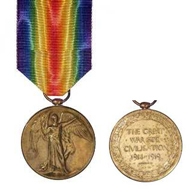
-
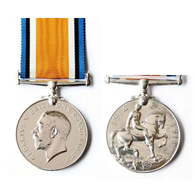
- Killed in action
- Did not return
- 14 November 1916
- Fleurs
- 19
- No known grave. Memorialised as missing at Villiers-Bretonneux Memorial
-
Eumundi & District Roll of Honour Board, Eumundi Memorial School of Arts Hall, Memorial Drive, Eumundi
Nambour (Maroochy Shire) Roll of Honor Scroll, Private Collection, Nambour (this scroll was available for sale to the public after the war) -
http://recordsearch.naa.gov.au(Service records WG Wells)
http://www.awm.gov.au/research/people/wounded_and_missing/ (Red Cross Wounded and Missing)
http://www.awm.gov.au/collection/records/awm4/23/42/ (War diaries)
Family recollections (Ron Lawrence)
http://trove.nla.gov.au (Memorial Trees)Images:
1 Studio Image of Wilfred Wells - Image donated from Lawrence Family
2 Postcard image of Wilfred Wells outside his tent on Salisbury Plains - Eumundi and District Historical Association Inc
3 Well's family home in Memorial Drive, Eumundi - Image donated from Lawrence Family
4 Colour patch - 25th Battalion AIF - http://www.awm.gov.au/encyclopedia/uniform/colourpatches/
5 "Mooltan" http://alh-research.tripod.com/ships_lh.htm
6 Villers-Brettoneux Memorial - http://www.cwgc.org/find-a-cemetery/cemetery/93000/VILLERS-BRETONNEUX%20MEMORIAL
7 Memorial Drive, Eumundi with very immature memorial trees surrounded by white picket fences - http://trove.nla.gov.au/work/154659480?q=Eumundi&c=picture&versionId=168583739
8 Mature memorial trees in Memorial Drive, Eumundi - http://www.eumundimarkets.com.au/media-content-photo-galleries/eumundi-memorial-drive
9 Eumundi & District Roll of Honour Board, Eumundi Memorial School of Arts Hall, Memorial Drive, Eumundi - https://www.google.com.au/search?q=Eumundi+and+District+honour+board+school+of+arts+building&source - Yvonne Atkinson






